1. Health
LAS VEGAS -- "Feel these balls. They're slick." Chris Harrington sounds exasperated, like a man whose Chinese delivery order has resulted in two piping hot pepperoni pizzas. He hands me one of the offending spheres in question: a tabletop foosball, smooth and firm. I pinch the ball, squinting and turning; Harrington tilts his head and shoots an expectant look. Well, doctor?
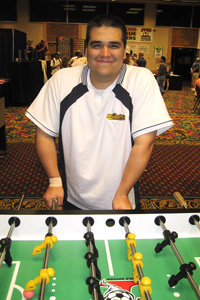
Patrick Hruby
Chris Harrington's wrists have the battle scars to show for his hours of foosball.
I give my best insincere nod, the one reserved for bosses and state troopers.
"I think the tables are warped, too," Harrington says. "Man, we bought new balls, tried to practice on new tables. And then they do this."
He takes the ball, drops it on the table in front of him.
"I'm pretty disenchanted."
And I'm fully confused. We're at the Riviera Hotel, right on the Strip, in a large ballroom just down the hall from a slot-choked casino. Surrounding us is foosball's top annual showdown, a Santiago de Compostela of table soccer: hundreds of players, dozens of matches, wall-to-wall tables. I see women with table rod handle wraps hanging around their necks, a man wearing a black and gold jacket reading $20,000 COLORADO STATE CHAMPION. I hear the whap-whap! sound of shots and goals. Atop three levels of metal scaffolding, a small crowd leans forward on hotel conference chairs, watching a contest that's being taped by a half-dozen cameras and broadcast live over the Internet, complete with color commentary.
Like, seriously.
Why would anyone take foosball so seriously? I'm trying to find out. Only Harrington isn't helping. He's too busy fiddling with the table's 5-bar, sweat beading between his bushy eyebrows and thick black hair. A 27-year-old airline employee from Wichita, Kan., Harrington has spent the past month batting little red balls around bright green tabletops into eight-inch holes. Five hours a day. Six days a week. All for naught. "That's a lot of muscle memory to break," he says, ruefully. "I just didn't adjust."
He leans forward, keeps talking, never looks up.
"Watch how the ball rolls," he says. "See it?"
Nuh-uh. But I do see Harrington's right wrist. It's bandaged. Right below his palm, covering the same area he jams against the 3-bar handle during "snake" shots, whip-fast blasts produced by rolling the handle from wrist to fingertips. "I tore off my calluses," he explains. Calluses? He removes the bandage. Underneath is an angry mass of inflamed flesh and cracked skin. "It hurts," he says, "and I can't feel the rod like I usually do."
SNAKE SHOT
TORN CALLUSES
CAN'T FEEL THE ROD
I write this down, suppress the urge to laugh. Harrington tightens his bandage. He shoots snakes, one after the other, wincing every time. Whap-whap! Around the room, I spy a dozen other wrapped wrists, a dozen other twisted faces. And though the whole masochistic scene isn't exactly the Spartans at Thermopylae, it does give me pause.
Maybe the question isn't why anyone would take foosball -- four rods, 11 plastic men, last seen in Joey and Chandler's apartment on "Friends" -- so seriously. Maybe the question is why anyone would take foosball seriously enough to endanger one's physical health.
"Hey," Harrington asks, "did you request this assignment?"
2. Dignity
I did. Largely for the opportunity to write passages like the following:
Nobody plays foosball because the table rod handles are shaped like ... well, you know. This is not for a lack of trying. In the documentary film "Foos" -- and yes, there is a documentary film called "Foos" -- Tornado brand table designer Bob Furr confesses that the handles on his original models were intentionally round and phallic, so that women would "love putting their hands around them."
Perhaps unsurprisingly, Furr's Freudian grips failed to attract an eager army of female players. Worse still, the subliminally sexy shafts were slippery, prompting an octagonal redesign that remains in use today.
When I share this tidbit with veteran fooser -- "fooser" being the term of art -- Tommy Adkisson, he arches an eyebrow.
"You're kidding," he says.
Nope.
3. Simplicity
Rod-spinning amusement. Rec room afterthought. Something you can (and probably should) play drunk. In a simpler, more idyllic time -- say, last month -- I saw foosball as happy hour fodder, as uninvolved as lawn darts.
Then I met Adkisson.
Adkisson is a foosball legend -- and yes, there are foosball legends -- a quick-shooting, trash-talking, nimble-footed pony keg of a man whose brash table manners might make him the most entertaining player in the sport. His backstory alone is script-worthy: Junior Olympic wrestler-turned-teenage foosball hustler; world champ at age 18; No. 1 for four straight years; later sent to prison for using and dealing meth (he got his start hustling dealers); now clean and sober and making a successful comeback.
"I wasn't right away good at foosball," says Adkisson, a 34-year-old Tulsa, Okla., resident. "But I was right away hooked. This game is very addictive. It's like soccer and chess, mixed. And there's always something new to learn."
It's the weekend before the Vegas tournament. We're at the Tulsa home of Adkisson's friend Justin Prokop, a semipro fooser. Plaques and trophies crowd the corner of an upstairs game room, next to a Tornado brand table -- a $1,400 pro grade model, same as the ones in Vegas.
To my surprise, the playing surface is not encrusted with rubies.
"Hey, we're talking about a machine," Prokop says, proudly patting the table's edge. "Not a toy you buy at Wal-Mart."Practice time. Foosball lesson No. 1: The table matters. Matters like grass and clay courts in tennis. Five different brands are used in pro play. Each brand has unique playing quirks: For instance, Tornado tables produce erratic bank shots, because the foosmen's feet are curved. (They really are. I checked.)
Lesson No. 2: Foosball is freaking hard. Adkisson shows me some basics. The 5-bar to 3-bar pass. The pull shot. The snake. My turn. I whiff on a half-dozen shots, send another one right off the table. The rods are extensions of Adkisson's hands; they feel like extensions of my earlobes.
Lesson No. 3: Mastering the rods is the easy part.
"I got the basic mechanics down in six months," says Prokop, a 32-year-old former Marine. "But then other players started blocking my shot all the time. I couldn't figure out why."
He wipes his forehead.
"That's when I realized this game is mental."
Consider foosball's basic confrontation: shooter versus goalie. Adkisson places a ball on the 3-bar, traces a finger along the goalmouth. There are three main shooting holes, he explains. The goalie bars can only cover two at a time. Balls move too quickly to block after they've been shot -- up to 45 miles per hour -- leaving goalies with two options: Guess where a shooter is aiming, or bait shooters into holes that only look open.
In foreign policy terms: unilateral pre-emption versus crafty realpolitik.
"You can't read someone's mind," Prokop says. "You're always guessing about the shot ..."
"But what you can do is come to a conclusion based on the percentages," Adkisson interjects. "You try to eliminate things based on what they like to do, or what they did last time."
Adkisson studies body language. Does the other guy always shuffle-step before shooting a pull? Find the tell. He likens foosball to football, to rock, paper, scissors. He talks about pressure. Pressure means hesitation. Hesitation means defeat.
Prokop gives me a tip: Each foosman covers a zone. Know where all 11 foosmen are at all times, and you can play pretty solid zone defense. (And yes, foosball has zone defense.) Also, mix up your tactics. Be unpredictable -- only don't think about being unpredictable, otherwise you'll end up … predictable. My brain feels like Harrington's wrist. Before I leave, Prokop hands me a small plastic box. The label reads FOOSBALL MASTERY. Instructional DVD, I figure.
"Watch this," he says. "It helps."
Later, on my flight home, I open the box. Seems I was wrong. It's not an instructional DVD.
It's a five-disc set.
4. Time for outside interests
FYI: Harrington was in Tulsa, too, even though he had returned from a trip to Peru the previous morning. He spent 33 hours in transit, arrived in Wichita before lunch, threw his dirty clothes in a washing machine and made the 2½-hour drive down to Prokop's place.
He then played foosball 'til 3 a.m.
Related FYI: Harrington does this regularly, because the opportunity to practice with Adkisson on a well-kept Tornado table is too good to pass up.
"My wife is very understanding," he says.
5. Glamour
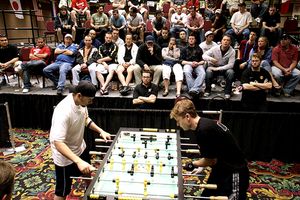
Ezekiel Moore
Frederico Collignon (right, playing with his infamous white glove) is the Michael Jordan/Tiger Woods of foosball.
Frederico Collignon is the world's best fooser. Maybe the best ever. A sleepy-eyed car salesman from Belgium, he lords over singles, dominates doubles, excels on every table type. He owns the fastest hands in the sport. Sees things other pros can't. Elevates his game in the clutch. Plays with artistic flair. Awestruck competitors liken him to Roger Federer, Michael Jordan and, occasionally, God in white batting gloves. (The gloves are Collignon's signature match accessory; unlike many players, he doesn't wrap his table handles in tennis tape.)
Of course, you'd never know this from meeting him.
I met Collignon in Vegas. Had no idea who he was. He was sitting on the floor in a hallway outside the ballroom, resting against a pillar. Typing on a laptop. He looked like a bored preteen playing Game Boy at a wedding; I pegged him for a tourist checking e-mail. Foosers and hotel guests and slot-pulling senior citizens walked past; no one bothered Collignon for a picture, requested his autograph or even said hello.
A little bored myself, I asked him what he was doing.
Watching soccer, he said.
Oh, you mean table soccer, like the stuff inside?
No, he said. Belgian league soccer.
I peeked at his screen. Real, low-res soccer players scampered around a real, low-res pitch, with the planet's premier puppet master of fake, miniature soccer players looking on. Life imitating an Escher painting. Later, I learn that Collignon had just notched a thrilling sudden-death victory in a doubles match dubbed the year's best.
In other words, I may have stumbled across Collignon's victory celebration.
My point? Only this: If Tiger Woods had just made an eagle to win the Masters, would you subsequently find him sitting on the curb outside Augusta National, quietly reading a book about putt-putt?
6. Respect
On my first day in Vegas, I meet Carlos. Dude is agitated. Needs to vent.
He hails from Costa Rica. Speaks a mix of Spanish and English. The women, he says. Most of the women on Costa Rica's national team -- and yes, Costa Rica has a national foosball squad -- had to stay home. They couldn't secure visas. American embassy staff thought their tourney invites were bogus, as legit as an e-mail scam.
A foosball world championship? Doling out $100,000 in prize money?
Yeah, right.
"They wouldn't even look at the applications," Carlos says with a sigh.
7. The Scene
Perhaps the Costa Rican national team just needs a tricked-out DeLorean. Believe it or not, tournament foosball once was a cultural phenomenon, complete with a national tour and full-time pros, big-money purses and a cash-in movie (1981's "Longshot"), dedicated magazines and dedicated foos music (sample lyric: "Partner, the Minnesotans are good/Ooo yeah, they love to put holes in the wood …"). Not to mention the surest barometer of prime-time status: groupies.
Pop quiz: During which time period did all of the above take place?
(A) The period that also gave America disco
(B) A
Anyway, don't take my word for it. Meet Kathy Brainard. A 55-year-old high school teacher from Cheney, Wash., Brainard co-authored a 700-page foosball almanac -- note: not a misprint -- and is a living encyclopedia of the sport. Today, she's staffing the United States Table Soccer Federation's booth in Vegas; in 1974, she was a foos-addled college student, thunderstruck by the nation's first major tournament, a $50,000 event held in Denver.
"We walked into a hotel ballroom with chandeliers and saw 100 foosball tables, people playing for thousands of dollars," recalls Brainard, who finished seventh in the draw. "It was just, wow. We were like, in a cult, like missionaries for this new religion. We just wanted to tell everybody about this game."
The ballrooms, the fancy lighting, the cult: all the brainchild of Lee Peppard, a Montana tavern owner and founder of Tournament Soccer, a Seattle-based foosball table company. In 1975, Peppard launched a modest $250,000 tour spanning 17 cities; by 1978, his Million Dollar Tour had weekly regional events and a $50,000 tournament every month.
Brainard saw everything: kids dropping out, living out of vans, chasing tables coast-to-coast; give-away Corvettes and Porsches; Sports Illustrated calling foosball "a first-class pro sport," only half in jest; top male players attracting female, um, admirers. "It was widely assumed," Brainard says, "that mixed doubles partners were getting together." Table sales soared. Tournament Soccer seemed invincible -- so unstoppable that Brainard took a secretarial job with the company in 1978, despite earning a master's degree in French literature. She soon found herself trading shots with Seattle Seahawks quarterback Jim Zorn and receiver Steve Largent during an NFL players' tournament.
(And yes, such an event actually took place.)
"Largent won, but he had some good coaching," she says with a laugh. "It was the most fun job of my life."
Brainard takes a deep breath.
"And then ..."
Space Invaders. Followed by Pac-Man. And disaster. Video game cabinets gobbled four to five times as many quarters as foosball tables. They invaded far less arcade space. Do the math. Tournament Soccer's business model went poof. In 1981, the company declared bankruptcy; the same year, popular champ Jim Wiswell was found dead in his home, victim of a suspected suicide. Foosball never recovered.
Brainard sips a frappuccino, flips through a copy of her almanac. Look here, she says: a photo of a large crowd watching a match. The text reads TOURNAMENT SOCCER: THE MILLION DOLLAR GAME. On the opposite page, a girl leans over a foosball table, her long brown ponytail pulled back.
KATHY BRAINARD. FIRST-PLACE WINNER.
"She looks very young, doesn't she?" Brainard says. "For some people, we may never regain those spectacular shining glory days. You walk in a room and it's not the big thrill it was before."
Brainard smiles.
"But there's still a lot of glory in today's game."
8. Money
Brandon Moreland digs glory as much as the next guy. He just wishes it paid better. The 27-year-old son of former champs Scott Moreland and Kathy Ginzer, Brandon estimates he has won between $60,000 and $70,000 playing foosball.
The catch? It took Moreland almost a decade to earn that amount. And he had to spend between $30,000 and $40,000 to do it.
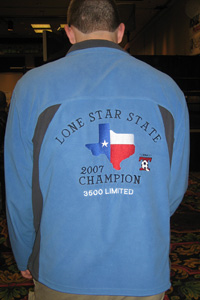
Patrick Hruby
Sweet threads like this can get you some serious street cred at a foosball tournament.
"Here [in Vegas], I need to win $1,000 to break even," he says. "For any player, to be up $400, $500 for a weekend is really fortunate. Unless you're Frederico. He makes bank."
He does. Between sponsorships (a few) and prize money (a lot), Collignon reportedly pocketed more than $60,000 in 2006. But he's the exception. Most foosball table sales are made to home users. Table manufacturers bankroll pro events. They have little incentive to boost prize money. Of the 14 major tournaments held in North America this year, only two have purses exceeding $40,000. The open singles winner in Vegas earns just $4,000, far less than the $7,000 awarded for the same title 30 years ago.
I'm sitting in the bleachers next to Adkisson, watching a match. He asks me if I've ever been to Dubai.
"I may go next year," he says. "I hear there's a $70,000 tournament. And the buy-in is only 50 bucks."
The Vegas buy-in is $300. Add flight, hotel, gas and food, and even top players can struggle to recoup expenses. Lesser players are out of luck, since lesser players don't win.
"In poker, the person who wins can be lucky as [expletive]," Moreland says. "Most people here are better off buying a raffle ticket."
Moreland sketches out a typical year's budget. It looks like this:
TOURNAMENTS: 10
AVERAGE WINNINGS: $500 (after expenses)
$300 per local tournament
$500 to 1,000 per out-of-state tournament
TOTAL WINNINGS: $5,000
"When you go from semipro to pro, it takes four years of paying dues and losing before you win," he says. "It's only in the last two years that I'm finally up playing this sport."
Has Moreland ever made money hustling? He looks at me like I'm speaking Klingon.
"You can't hustle people at foosball," he says. "Every now and then you'll find a drunk dude that wants to play for drinks or 20 bucks. But most people know that they suck. And I can't act like I'm bad enough to fool them."
9. Romance
The good news? Foosball is a great way to meet women. The bad news? You have to cross the Atlantic Ocean to do it.
While foosball remains stagnant in the States, the sport is booming in Europe. Germany has an estimated 30,000 to 40,000 league players. France is home to the International Table Soccer Federation, an organization pushing for Olympic foosball. Two years ago, Hamburg hosted a Table Soccer World Cup that coincided with the real thing; European broadcasters covered the event, and a USA-France match drew 1,500 spectators.
Brainard and others say foosball's overseas popularity stems from its continental origins -- the oldest known foosball table is French, and dates back to 1903. But Moreland has a different theory.
"In Europe all the girls who play are 18-19 and hot as [expletive]," he says. "So all the guys play, too."
10. Early retirement
Day 2 in Vegas. Brainard is talking foosball strategy. And male psychology. The two overlap. Brainard still competes -- she placed third as a member of the U.S. national team at last year's World Championships in Italy -- and is about to play goalie in a doubles match.
"Fortunately for goalies, most men's egos are so great that they want to shoot the long, powerful shot that goes to the long hole," she says. "They want to show they can beat you every time. Some can. But others, you can cheat: Leave an obvious hole, and they still won't take ..."
A middle-aged man interrupts. His name is Scott. He's a holdover from the Tournament Soccer era, lives in Florida. He wears a single white glove.
"Wow, Kathy, you look beautiful," he says. "You haven't changed a bit."
"Thank you. Are you playing senior doubles?"
Scott scans the room, wide-eyed.
"I haven't been back to one of these for eight years," he says.
Funny thing about foosers: They always come back. May as well be checking out of the Hotel California. Prison couldn't keep Adkisson away -- while incarcerated in Texas, he ran an inmates foosball league. Cindy Head, an Alabama cop and the best female player ever, has endured three surgeries on her left hand and retired from competition at least five times. She's playing in a match right now. Moreland's father is on hand. So is Rick Martin, a 1977 world champ who quit foosball in 1983 … and didn't even touch a table rod for the next 22 years.
"I'm just sticking my head in the world to see how it has evolved," says Martin, a 52-year-old Boise resident who works in real estate and remains Idaho's first and only pro. "I'm like the guy out of the Ice Age."
No comeback?
"Not really."
Later, I spy Martin hunched over a table.
11. Dignity (II)
At the far end of the Riviera ballroom are two folding tables, loaded with foosball doodads and staffed by a guy named Mike. He's selling handle wraps, two bucks apiece. He's also hawking tubes of liquid silicone. I ask why.
"To lube the [table] rods," he explains. "People used to use beer."
12. Television exposure
ESPN last aired foosball in 1996. The sport hasn't appeared on a broadcast network since 1980 (when it was introduced by a young, clearly perplexed Bryant Gumbel). While poker, bass fishing, eating contests, competitive cooking and celebrity poker all have found niches in the ever-expanding cableverse -- keep hope alive, adult kickball! -- table soccer has languished in the wilderness.
Phil Schlaefer hopes to change that.
Schlaefer leads me to an empty Riviera conference room. He sports a blonde goatee and thin-rimmed glasses; muscled forearms pop out from his NFL Alumni Golf Classic polo shirt. He flips open a chrome laptop. On the screen is a promo reel: "The Foosball Master Tour," a show Schlaefer is shopping to various networks.
"This pitch is top secret," he says. "Only a handful of people and executives have seen it."
The aesthetic? Poker meets X Games meets MMA meets foosball. Think flexing biceps. Rocking guitar riffs. Squinting close-ups. A computer-rendered foosball arena/death pit mock-up that brings to mind a Kirk-versus-Spock pole fight. Even the voice-over guy -- "one ball … one game … one mission … WIN!" -- sounds kinda badass.
"That's actually me," Schlaefer says, laughing. "I was a runner-up for the [Oakland] Raiders P.A. job a few years back."
A 45-year-old Bay Area resident, Schlaefer has been foosin' for three decades: running arcades, organizing tournaments, distributing tables, inventing and selling game accessories. He makes custom tables for Warner Bros. -- he's currently tricking one out for rapper E-40 -- and has enlisted Hollywood help for the Master Tour, including a former Disney animation director and Matt Savage, who directed the World Series of Poker.
Poker is the model, Schlaefer says. Now break it down. Twenty-two minutes of airtime. Only four hands of card-playing. What makes it work? Personality. A cast of characters viewers can root for.
"We have a Samoan guy who lives in Hawaii -- big as a house, scary-looking dude, has the fastest-recorded shot in the world," Schlaefer says. "But he's a big teddy bear. He'll sit at tournaments and play music on this tiny ukulele. There's another guy, Chris Dube, who's been a midget wrestler for 20 years. He's a top-20 foosball player. Plays on custom stools."
Schlaefer hits a button. Up comes video of Adkisson. Dubbed "Tommy Two-Gun," he crosses his arms and glares into the camera. Superimposed text reads:
RANK: MASTER
SHOT STYLE: SNAKE/PULL
TORQUE FACTOR: 88 PERCENT
Um, wait. Torque factor? "If you watch the rod when they shoot, it bends," Schlaefer says. "It torques like an engine. That makes the power ..."
Oops. I think he sees me smirking.
"OK, we made that up. It's window dressing. But it's cool. Don't tell anyone."
Can torque factor serve as foosball's Chris Moneymaker? Schlaefer gives me his closing argument, the one he gives to network execs: I've run tournaments for Yahoo, Cisco, Apple, eBay. They all have tables. Everyone has played foosball. It's a sleeping giant. And if that giant awakens ...
"You'll see foosball tables in every freaking sports bar in the country," he says. "We get this on the air, I'll even come out of retirement as one of the characters."
Come again?
"Oh, yeah. Back in the day, my nickname was Dr. Doom. We might play that up in Season 2."
13. Would you believe ... enlightenment?
By Day 3, my head hurts. My feet hurt. I still can't shoot a pull shot. And I'm still not sure why anyone would take foosball seriously enough to call oneself a doctor, let alone require the services of an actual medical professional.
Fortunately, I've finally found the right person to ask.
Jim Stevens owns the Web site InsideFoos.com. He's the guy behind the cameras, the stage, the online broadcasts. He sells match DVDs. Calls the play-by-play himself, sort of making him a foosball hybrid of John Madden and Steve Sabol.
Like any decent sportscaster, Stevens speaks quickly and clearly. Get him rolling, and he'll break down doubles foot signals, compare Collignon to a major league pitcher, devote 10 full minutes to the ongoing, excruciatingly esoteric intrasport debate over the snake shot.
(In a nutshell: Younger players love the snake, which caught on in the early '90s, because it's easy to learn and hard to block. Meanwhile, older players view it the way Obi-Wan Kenobi viewed the hand-held blaster: an inelegant weapon for a less civilized age.)
"There's so much more to this game," Stevens tells me, "than anybody realizes."
We're sitting in a makeshift broadcast booth, surrounded by laptops and digital cameras. The cameras are pointed at a foosball table, illuminated by stage lights and backed by bleacher seats. This is Table 1, a place where veteran players sometimes wilt -- and unknown novices occasionally shine.
"The guys that overachieve, that says something about them," Stevens says. "It says they're honest. With themselves. They don't spend time feeling guilty or worried about what others think."
I'm lost. Stevens continues. He coaches players, too. Tells them the following: Don't worry. Don't even think. The ball moves too fast. The decisions happen too fast. Just be in the moment. Allow yourself to happen. Practice and prepare, but then let go. Surrender self-awareness.
"This game can put you in a zone where you almost step outside yourself," he says. "It's Zen. So empowering. The pleasure zones in your brain, they get incredibly stimulated. When you're playing well, it's the closest you can get to perfection. You're almost performing magic."
It sounds spacey. Out there. I wonder if Stevens is working on one of those checkout aisle self-help cash-grab books, something like "Zen and the Art of Foosball." (Actually, a book with that title already exists. I looked it up.)
On the other hand, the guy might be on to something.
I watch a match. Not just any match. Moreland and Tony Spredeman against Collignon and Todd Loffredo. Best contest of the day. If Collignon is foosball's Luke Skywalker, then Loffredo is the sport's Obi-Wan: the most decorated player in history, dominant for three decades, renowned for making the right play at the right time, an active Hall of Famer.
(And yes, foosball has a Hall of Fame.)
Amusing FYI: Loffredo, a 48-year-old Columbus, Ohio, resident, is a practice partner of foos-lovin' golfer Paul Azinger.
Amusing FYI No. 2: He totally looks like the Fonz.
Collignon and Loffredo wear matching T-shirts. Spredeman and Moreland sport low-slung ball caps. The match is taut, tense. It goes to a fifth and final game. Moreland bounces on his toes, blows into his palms. Collignon calls for time, adjusts his white gloves. The score is 5-5, then 7-7. Next ball wins. Moreland blocks Collignon, who promptly returns the favor.
The ball ends up on Loffredo's goalie rod. He waits. And waits.
Whap-whap!
"Yeahhhhhhh!"
It's over. Loffredo scored. From across the table. In an instant. So fast that I never saw the ball. The players shake hands. Afterward, Moreland explains what happened: Loffredo blasted something called a Pull Kick Bank off the far wall -- a chancy, crazy, out-of-this-world shot, like running a double-reverse flea-flicker on fourth-and-long.
"He made it 50-50 right there, all or nothing," Moreland says, dumbfounded. "It was so out of character. And Todd just destroyed it."
I find Loffredo at a nearby table, hanging out with Harrington. What, I ask, were you thinking? A bank shot? On a curved-foot Tornado table? On match point?
Loffredo smiles. He says that the far wall bank was always one of his best shots in the Tournament Soccer era. That he practiced the shot before the match, because Moreland leaves that hole open. That it was risky, yes, and borderline dumb, because he already attempted the shot twice in the match, missing both times.
I listen. I think about Stevens, and Harrington, and all the other foosball junkies, love and obsession and bandaged wrists. Zen and magic. I ask a better question.
Were you thinking at all?
"It was just time," Loffredo says with a shrug. "There's a lot of things in this game that are feel."
14. None of the above
He pauses. He holds up a little red foosball, smooth and firm.
"Besides, I knew these balls would be slick. And it's really a slick-ball shot."

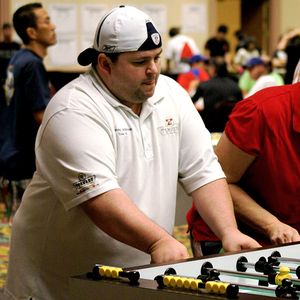
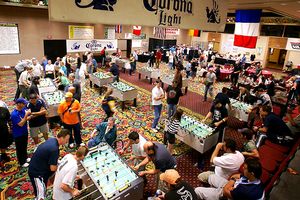
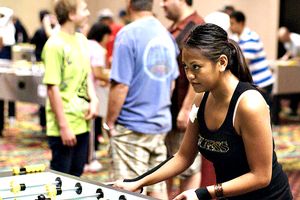
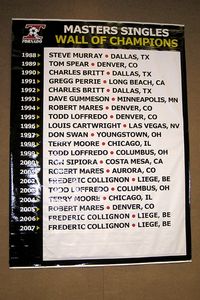
Comments
You must be signed in to post a comment